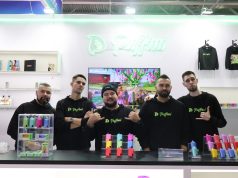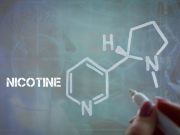Once upon a time: the origins
This topical subject could actually find its origins in the early Vap-ocene, the so-called great era of the vape. As highlighted by Oliver Kershaw in a recent article published on his website, vaping.com, the first warnings were written in forums in 2010. At that time, users were already discussing comments made by some vendors, such as Liberty Flights, for example, that explained being aware of the presence of diacetyl in e-liquids.
—
Important notice : According to our analysis, the risk reduction provided by the electronic cigarette against the smoked tobacco can in no way be put into question, and whatever the current discussions on the possible presence of these compounds in e-liquids.
—
Aroma sellers like LorAnn, FlavourArt or Perfumers Apprentice, have communicated on the subject by reassuring customers on the innocuousness of their products with regard to diacetyl. But to what do they refer?
Diacetyl and lung diseases: the case of popcorn workers
Diacetyl is a chemical molecule also called 2,3-butanedione according to the International Union of Pure and Applied Chemistry (IUPAC). Diacetyl occurs naturally as a result of certain fermentation processes and is found in beer, wine and dairy products without presenting any risks for health. But ingesting is not inhaling and this diketone belonging to the general class of volatile organic compounds (VOCs), relatively inoffensive when absorbed in the digestive tract (National Institute for Occupational Safety and Health, 2011; FEMA Nr 2370), may be involved in severe respiratory dysfunctions when inhaled by a subject.
In opposition with the digestive tract, the respiratory system does not have the same powerful enzymes and metabolic detoxification pathways. Therefore the harmless VOCs intended for ingestion by the flavoring industry may potentially introduce a toxicity upon inhalation and become harmful for health.
In 2007, the International Union of Food (IUF) published a statement alerting on a particular risk of exposure to diacetyl. This international federation of trade unions represents workers employed mainly in the food sectors, hotel services and processing of tobacco.
The agency explains that “the use of diacetyl as a synthetic food additive rather than natural diacetyl could lead to serious health concerns”. Used alone or in combination with other chemical ingredients to produce an artificial butter and creamy flavor, diacetyl is generally referred to as “artificial flavor” or “artificial butter flavor”.

This takes us back to the early 2000s when an increasing amount of scientific studies reported a link between inhaled diacetyl and an airflow obstruction called “bronchiolitis obliterans”. This severe inflammation of the lung was termed by the American media the “popcorn workers lung” disease as it arose among workers of a microwave popcorn plant exposed to butter-flavored volatiles, particularly diacetyl [1]. Other cases of the obliterative bronchiolitis were further reported among workers exposed to diacetyl in the worldwide flavor manufactoring industry.
The obliterative bronchiolitis is a rare and irreversible disease that quickly destroys the bronchioles, the smallest airways connected to the alveoli, and thus leads to a sharp decrease in breathing capacity. This severe disease is deemed “debilitating, progressive, irreversible and potentially fatal” according to the IUF, which raises awareness among the food workers about the risk of being exposed to grave danger. Diacetyl can indeed be easily inhaled through “vapor, droplets or dust” in the manufacture of certain foods.
From pop-corn to e-liquids…
The foundations of a fear to diacetyl in the food industry is finally laid in 2006. And it will take another 8-year for the story to reach the domain of e-liquids when, associating the use of food grade flavorings with the universe of the vaporizer, a well known European scientist has gotten interested in the question in 2014.

Dr. Farsalinos, one of the most prolific researchers on topics related to the electronic cigarette, conducted a study funded by a internet crowd-funding campaign and aiming at detecting the presence of diacetyl in the e-liquid [2]. A total of 159 samples purchased from 36 manufacturers and retailers in 6 different countries (Europe and USA) were analyzed. The results were astonishing!
Over a wide range of products (159 sweet e-liquids from 36 manufacturers, retailed in 7 countries) 74.2% contained diacetyl or acetylpropionyl. The latter is also a diketone VOC known as 2,3-pentanedione and similar in structure to diacetyl, which implies the same risk for health. Acetylpropionyl has become a popular substitute of diacetyl after it had been demonized for its role in the “popcorn worker’s lung” disease.
Even if it makes no doubt that these substances contained in the e-liquid are readily transferred to the aerosol inhaled by the user, an attempt to compare the dose delivered when smoking tobacco to that of vaping on e-cigarettes, confirms the relative benefits of this method for public health with a transfer potential 10 to 100 times lower.
Describing the occurrence of these two compounds in the samples as “an avoidable risk“, Dr. Farsalinos underlines that alternatives exist to give liquids a sweet taste without using diacetyl or acetylpropionyl. Under those conditions, the “tolerance zero principle should be the rule”, he thinks.
Added deliberately by the manufacturer as an ingredient or resulting from contaminations in the manufacturing process, both compounds should be tracked through the production process. Farsalinos and co-workers raise awareness among the e-liquid manufacturers, on the need to establish more rigorous manufacturing processes.
Exposure limits remain vague when transposed from the continuous occupational exposure in a working place to the recreational exposure to e-cigarettes aerosols. The thresholds provided by the National Institute for occupational Safety and Health (NIOSH) refer to the air content and continuous exposure while vaping is recreational an intermittent. A methodological effort should then be considered in order to harmonize exposure limits with vaping.
Greed against conscientiousness?
The fact that diacetyl or acetylpropionyl give the steam sweetness has probably made it difficult for manufacturers to self-discipline on their use. One must say that the ” juices ” made in America have been on a roll since they possess a typical creamy flavor that is a guarantee of good performance in sales. So good that their attractiveness could have put a flea in the ear of some dealers.
Since the concentration limits and their potential effects on health are questionable, the reliability of the analysis is also under concern with laboratories that do not necessarily find the same results for the same liquid.
But the problem here is the fuzziness with regard to the presence of potentially harmful ingredients like diacetyl or acetylpropionyl in e-liquids. Many retailers (the British Cloud9vaping, the French Taklope and Le Petit vapoteur, and the American Vapor Shark) were concerned about the quality of their products and have commissioned independent laborartories for the analyze of some e-liquids present in their catalog, and in their target were US brands’ popular creamy flavors (e.g. Suicide Bunny, Five Pawns or Alien Vision).
Independent analyses returned exceptionally high values if one falls in with Farsalinos’ tolerance zero rule.

In the absolute and compared to the data provided by the manufacturer’s (if any), some of those analyses returned extremely high values. Ranging from 400 ppm* [3] in Mother’s Milk (Suicide Bunny), to 1144 ppm [4] in OB (Suicide Bunny), and up to 1800 ppm [5] for The Drifter (Vintage E-liquids) or even 2500 ppm [6] for Absolute Pin (Five Pawns).
Such ads has expectedly provoked strong reactions from the companies and raised legal conflicts. If the concentration limits and their potential health effects are questionable, information transparency is required with regard to the reliability of the chemical analysis. The differences call for caution with respect to calibration procedures and detection limits** that may reflect the range targeted by safety levels.
A transparency effort comes nowadays from the manufacturers themselves, as shown by the example of Vapor Shark but also the British giant Totally Wicked that have scrutinized the chromatographic analysis of the entire range for the possible presence of these two compounds. Nothing to report, and the manufacturers congratulate themselves.
The case of the American manufacturer NicVape also illustrates this trend in transparency regarding diacetyl and acetylpropionyl. By posting on its homepage that its previous supplier had lied about the alleged absence of these two compounds, the juice maker loudly claimed its new commitment to consumers and now warrants its e-liquids are free of those substances. A logo was even created to visually attract the customer’s attention on the qualitative aspect.
In the light of some reactions on social networks a certain portion of consumers claimed to be attentive to such information. But can these concerns, on the large scale, have real commercial echoes?
Some professionals react
The Electronic Cigarette Trade Association (ECTA) of Canada did not wait for the controversy to swell before reacting and communicating with members. Since July 2015, the ECTA of Canada has asked members to submit on a bi-yearly basis, e-liquids samples to evaluate the chemical nature of the products sold through its network. Independent quantitative analysis encompassing nicotin, diethylene glycol, acetaldehyde, formaldehyde, and also diacetyl and acetylpropionyl is then carried out and charged to the manufacturer himself.
Referring to the limits published by Farsalinos et al. (2014) with respect to diacetyl and acetylpropionyl, ECTA has attempted to define, with certain precautions, acceptable thresholds for the manufacturer.
Below 22 μg/ml (ppm) for diacetyl and 45 μg/ml (ppm) for acetylpropionyl, the manufacturer is not required to change its marketing policy even if the ECTA standard to which all members must strive to achieve is non-detection of both compounds. If rates exceed these thresholds, manufacturer is invited to inform its customers of the presence of the compound in the recipe of its e-liquid and reformulate it in order to remove the cause of the compound. The immediate withdrawal of the e-liquid is requested above 100 μg/ml.
Establishing internal standards is generally approved by consumers, but are these requirements achievable? Are all creamy or buttery e-liquids threatened?
Diacetyl or the buttery cuisine
The problem seems complex because these compounds are rooted in the flavoring manufacturing processes as a part of the production chain. It can sometimes be difficult for a manufacturer who buys his products from a catalog that compiles different vendors worldwide to be aware of their presence.
If the manufacturer can obtain the guarantee of buying pharmaceutical grade propylene glycol (PG) or vegetal glycerin (VG), the molecular nature of concentrated aromas could be much more complex to evaluate.

Vincent Cuisset, manger of the eponym company “Vincent dans les Vapes” (“Woozy Vincent”) explains that a flavor, “whether natural or artificial, manufactured under a particular support (gum, ethanol, molasses, PG, acetin, oil…) contains different types of aromatic molecules (ketones, terpenes, thiols, lactones, pyridines…)” among which some are potentially harmful when inhaled.
It is easy to imagine how puzzled a e-liquid manufacturer, whose expertise can sometimes lie in assembling ingredients only, facing advanced analytical constraints without the competences of a chemical engineer. To know whether the flavors he buys per kilogram contain diacetyl or acetylpropionyl requires that the supplier communicates this information. But according to some sources close to the industry, this is not all the time the case.
Yet, in Europe, “the food flavorings manufacturers and sellers must deliver products that comply with EEC regulations 1334-2008, which sets specific purity criteria for substances that could endanger consumer health” explains Vincent’s collaborator on forum-ecigarette.com [7] .
“But food flavorings may contain other substances that can be dangerous or for which harmful effects or benefits on health upon inhalation have not yet been demonstrated” continues the manufacturer: ” lead, copper, arsenic, zinc (heavy metals), pulegone, coumarin, quassine, cinnamaldehyde, beta-asarone… long is the list, not to mention GMO substances, pesticide residues, sugar syrup , gum…”.

Failing to expect from his supplier to provide some of these critical data, the solution lies in the systematic testing of home-made receipts, once achieved. But discovering the offending aromatic compound in a mixture of multiple flavors can be tricky. How to satisfactorily discriminate among several aromas which one contains diacetyl or acetylpropionyl?
Facing potentially dangerous compounds upon inhalation, the scientist can only rely on empirical approaches. Up to the professionals to establish a list of compounds that they do not wish to incorporate in their recipes.
Discarding certain molecules for their dangerousness is one thing, but won’t it allow some others to offset a lack of taste and return the same issue? For we must remember that the dose makes it toxic, not its mere presence in a product.
The aromatic Rosetta Stone
To our best knowledge the game of decoding desirable aromas or not in e-liquid has already begun in the laboratories of some French manufacturers. But work takes time and the onset of this professional expertise is very recent… and promising!
The cost of a chemical quantitative analysis of those molecules ahead of the production may represent a significant investment for a manufacturer and integrating systematic checks beforehand of his production may impact the economic balance of manufacturing.
A radical solution to the manufacturer, hire an engineer and invest in a gas chromatograph (GS-MS).
Depending on the detection limit in target, the initial investment for such a technological device ranges between 100 000€ and 250 000€ to what are added the wages of a qualified employee to handle the device and interpret the results. But the game is worth the effort because, as the old saying goes “one is never better served than by oneself “. The most efficient way to keep under control all products, from the nicotin can to the smallest aromatic molecule?
In France, the FIVAPE reacts

The FIVAPE (Fédération Interprofessionnelle de la Vape), the French counterpart of the Canadian ECTA, shared some comments with PGVG. Vice president and manufacturers’ general secretary, Charly Pairaud and Xavier Martzel, explain.
The revolution in the world of the e-cigarette, over the last 10 years, was built in opposition to the dangers of smoking, as a main goal, with a strong will to place risk reduction at the heart of its development. But nowadays, we are forced to regard it as a disruptive innovation that exceeds the initial expectation.
The e-cigarette is neither positioned as a byproduct of tobacco, nor as a medicine but it remains compared to tobacco cigarettes with regard to health safety.

FIPAVE’s position on the e-cigarette merges with ECTA of Canada and regards e-cigarettes as an effective harm reduction device compared to tobacco cigarettes. But their mission, from the European’s point of view, is slightly different.
“Vaping doesn’t need not be 100% harmless but must strive for optimum safety as its science advances.”
The growing concern about the presence of toxic compounds, including diacetyl and acetylpropionyl, has been relayed by the FIVAPE that works on reliable solutions. The application of the French Association for Normalization’s (AFNOR) standards would be a world first for quality and product safety. The FIVAPE supports this initiative as it deems unrealistic to completely banish those molecules that confer the flavors prized by many customers. If this flavor cannot be achieved thanks to diacetyl in response to an overly strict legislation, it will be obtained through other molecules beyond any legal framework and whose toxicity remain to be established, and it is already the case for the acteylpropionyl that requires concentration above diacetyl for a similar aromatic intensity.
The FIVAPE aims at being an interface between health professionals and the consumer
In order to satisfy the consumer, it is essential to put face to face medical professionals, on the one hand, and manufacturers, on the other hand, to establish the first bases for a standardization. This standardization is intended to define the legal framework to which manufacturers should refer to and that will guarantee the consumer a transparency in quality. In response to the call of the FIVAPE, the European Committee for Standardization has also launched a workshop among the european states.
Learning before reprehending

Unlike ECTA, the FIVAPE does not plan to carry out any analysis as long as the harmonization effort is unsuccessful. Given the complexity of the recipes and variety of flavors, it comes under the moral responsibility of manufacturers to ensure seamless transparency on the compounds present in the e-liquids, so that scientific effort remains focussed on product development rather than to outbid detection of trace compounds. And that’s what the FIVAPE is currently working on.
In the eyes of our two interlocutors, a legal frame is a requirement so that the vaping products continue to provide an alternative and satisfactory solution to tobacco smokers.
Notes:
* ppm (part mer million) is a mesure of the dilution and refers to one unit of a substance in 1 000 000 units solvant, i.e. mg/L or μg/ml.
** detection limits. The GC/MS (gas chromatography and mass spectrometry) testing, one of the most common and least expensive true tests for diacetyl and acetylpropionyl generally show a detection limit (MDL or LOD) of 0.1%. That is 1000 µg/ml or 1000 ppm, which is not suitable to show any substantial evidence of safety level. Therefore, the most sensitive detection limit is required to either find or rule-out diacetyl and acetyl propionyl in any commercially marketed e-liquid.
References:
[1]KREISS, K., GOMAA, A., KULLMAN, G., et al. Clinical bronchiolitis obliterans in workers at a microwave-popcorn plant. New England Journal of Medicine, 2002, vol. 347, no 5, p. 330-338.[2]FARSALINOS, KE., KISTLER, KA., GILLMAN, G., et al. Evaluation of electronic cigarette liquids and aerosol for the presence of selected inhalation toxins. Nicotine & Tobacco Research, 2015, vol. 17, no 2, p. 168-174.
[3] analysis commissioned by Taklope (April, 2015)
[4] analysis commissioned by Le Petit vapoteur (April, 2015)
[5] analysis commissioned by Vapor Shark (June, 2015)
[6] analysis commissioned by Cloud9Vaping (June, 2015)
[7] “Liquides & arômes sans Diacetyl ou substituts” – Question de Leopold du 11 avril 2013 – http://www.forum-ecigarette.com/vdlv-avis-f799/diacetyle-acetoine-acetaldehyde-t84185.html











